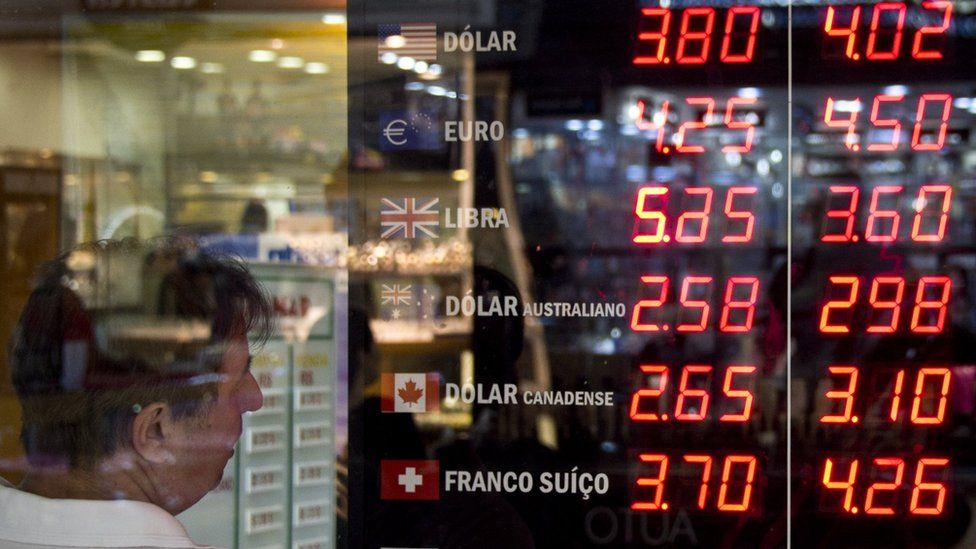Real worries: Why is Brazil's currency now so weak?
- Published

Tourists who came to Brazil for last year's World Cup are probably lamenting the fact that the tournament wasn't held in 2015 instead. Since the beginning of the year, Brazil's real has been one of the fastest-falling currencies among major economies.
A tourist arriving in Rio de Janeiro with $6,600 (£4,300) in January would have been able to book a suite for a week in the city's luxurious Copacabana Palace. Now the same amount of US dollars can stretch to ten nights.
Brazil is not alone in its currency woes.
The devaluation is a worldwide trend among many currencies due to different factors; from China's slowdown, the fall in commodity prices and the US's imminent decision to raise its interest rates. When that happens, some investors are likely to leave riskier emerging countries for safer gains in the US.
But Brazil also has severe domestic problems that are taking its toll on the currency.
The year started with a big challenge for Brazil's newly re-elected President Dilma Rousseff, as everyone expected the economy to contract.
Brazil's government had been overspending in the previous three years and markets were wary that soon the country could be in a situation where it would be hard to service its debt.
Despite problems, there was some degree of confidence that Ms Rousseff's market-oriented Finance Minister Joaquim Levy could reign in spending, as he was given strong support from the president.
Sao Paulo's Bovespa index grew slowly but steadily until May.
Junk status
But the second half of the year has seen Brazil's crisis turn sharply to worse.
In July, Mr Levy acknowledged that despite his best efforts, the government would not be able to meet this year's spending target - needed to lower the country's debt burden.
Under pressure, the government took one of its most controversial decisions a month later.
It sent congress a budget proposal that predicted the government would run a deficit next year.
Ms Rousseff's economics team thought the proposal was a strong message to congress, that if legislators didn't help the president cut spending, Brazil's economy would suffer massively.
But this signal was picked up by the markets instead.
In September, that decision was the basis for Standard & Poor's decision to downgrade Brazil's economy to junk status.
The credit ratings agency said the 2016 budget proposal put in doubt the "government's ability and willingness" to hold to the policy correction course set out initially by Ms Rousseff.
The downgrade sped up the real deterioration - as many international funds have rules that ban them from investing in junk-rated countries.
On 22 September, the Brazilian real reached its lowest-ever value on record. Since May, the Bovespa index has fallen by almost 20%.
Beating hyperinflation
Keeping the real stable is vital for the Brazilian economy.
"The real is much more than just a currency. This is a long conquest for the Brazilian people", says Miriam Leitao, a journalist and author of a best-selling book on the history of Brazil's currency.
Created in 1994, the real effectively put an end to decades of a disease that corroded the Brazilian economy: hyperinflation.
Every year from 1942 to 1995, Brazil never had anything less than double-digit inflation per year. In the 1980s and 1990s, it had four-digit inflation.
The real successfully defeated hyperinflation by keeping itself overvalued against the dollar for a few years. That, coupled with lower tariffs, flooded Brazilian markets with imported goods - and competition forced local producers to keep their prices from climbing.
The currency went through tough challenges in 1999 and 2003, but authorities managed to stave off pessimism and restore credibility with policies aimed at keeping inflation down.
How long and how deep?
Ms Leitao believes the current troubles are related to a confidence crisis in the government's ability to do the same now.
The problem is the collateral damage done by the intense volatility - no one knows how long the current devaluation will last and if the currency will ever come close to its previous value.
"This volatility is disturbing for businesspeople. It raises some debts, it creates uncertainty, it affects investment decisions, such as how much a company should export or import", she says.
Some are benefitting from the situation. Firms that can export from Brazil are now doing so.
One multinational car maker celebrated the fact that producing a car in Brazil had become cheaper than in China - just because of exchange rate fluctuations.
Swedish truck maker Scania has seen its sales in Brazil drop massively because of the economic crisis, but it is now increasing sales from its Brazilian factory to other South American countries.
Will it work?
But longer term decisions are harder to make.
The fate of Brazil and its currency depends on how the economic and political crises unfold.
It is unclear whether President Rousseff will gain political support for her reforms - and even if she succeeds in that, there are still questions of whether her plan will work or not. And Brazil still has to watch out for what happens in China and the US.
In fact the real has gained some of its value in the past few days, with news that America's Federal Reserve might postpone its interest rate rise for next year.
Still, guessing how many nights a few thousand dollars will buy in the Copacabana Palace for next year's Rio Olympics is a tough challenge right now.
- Published2 October 2015
- Published10 September 2015
- Published28 August 2015